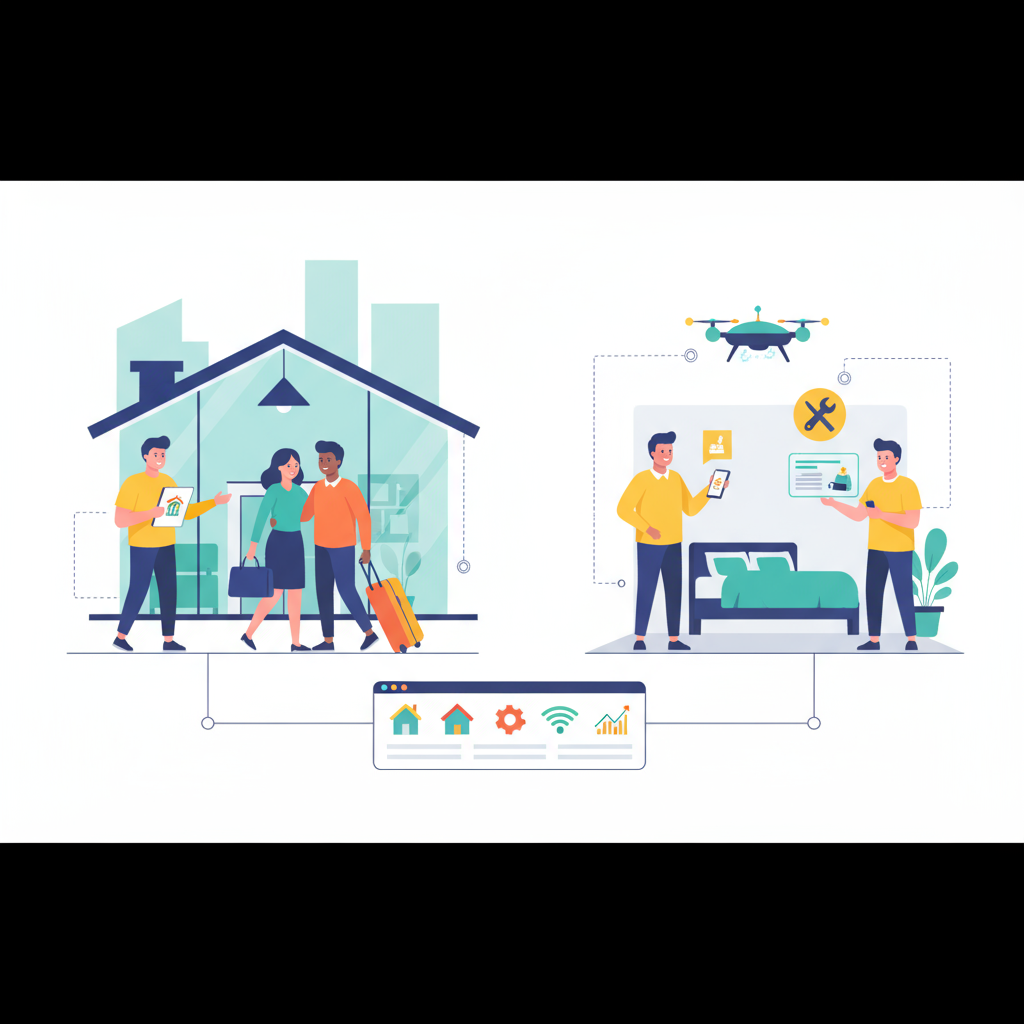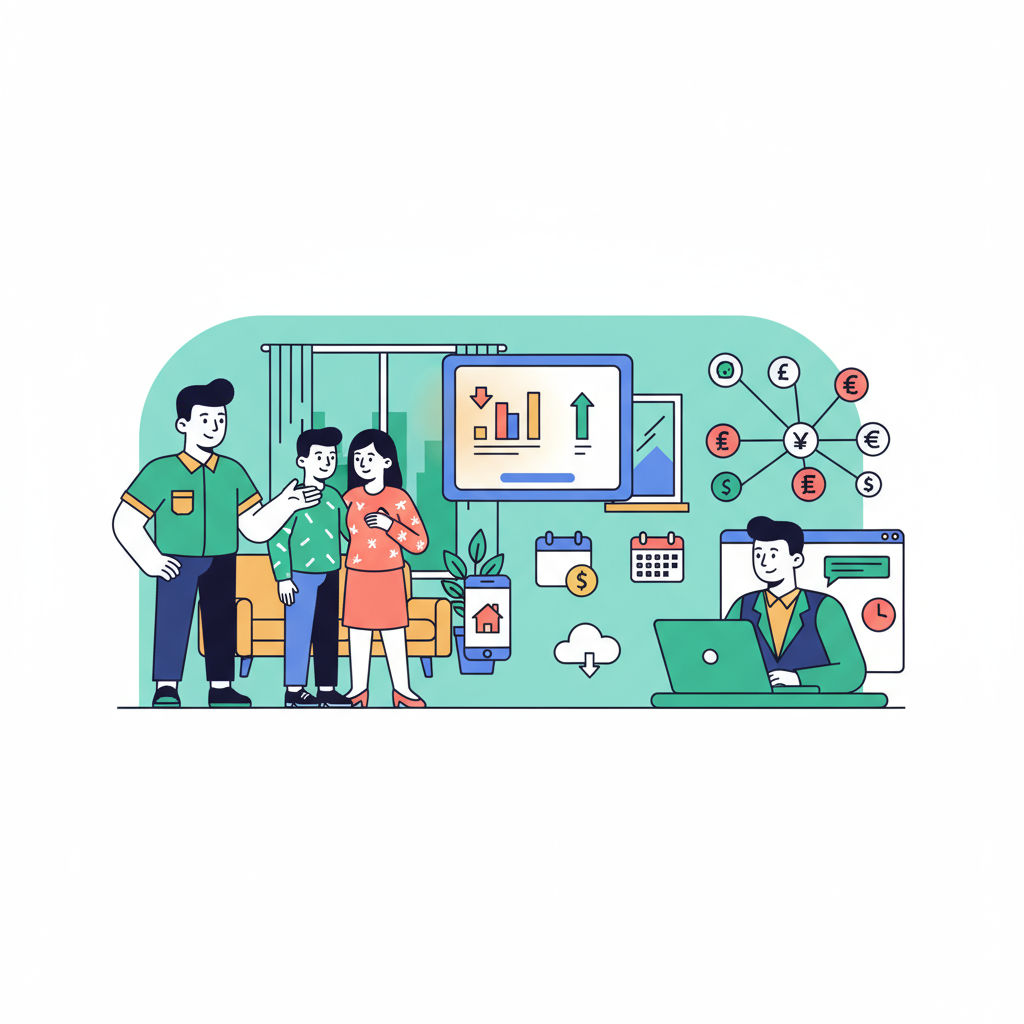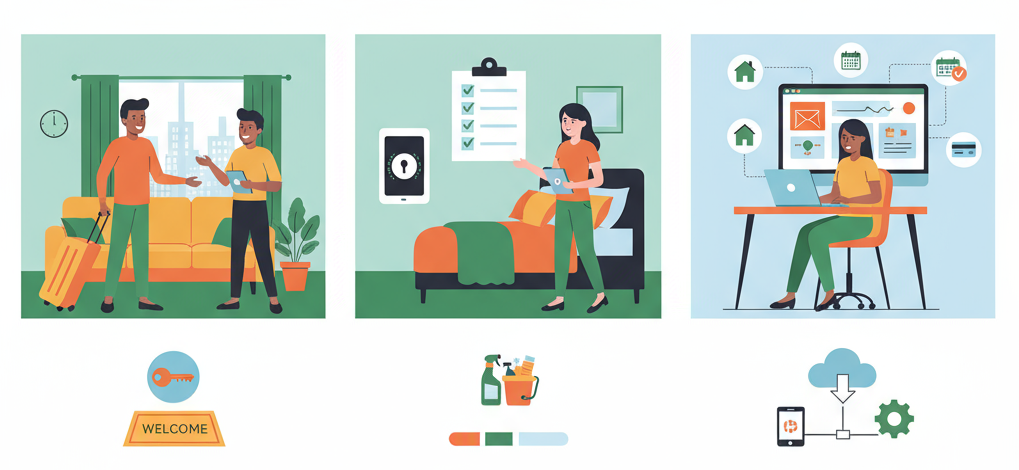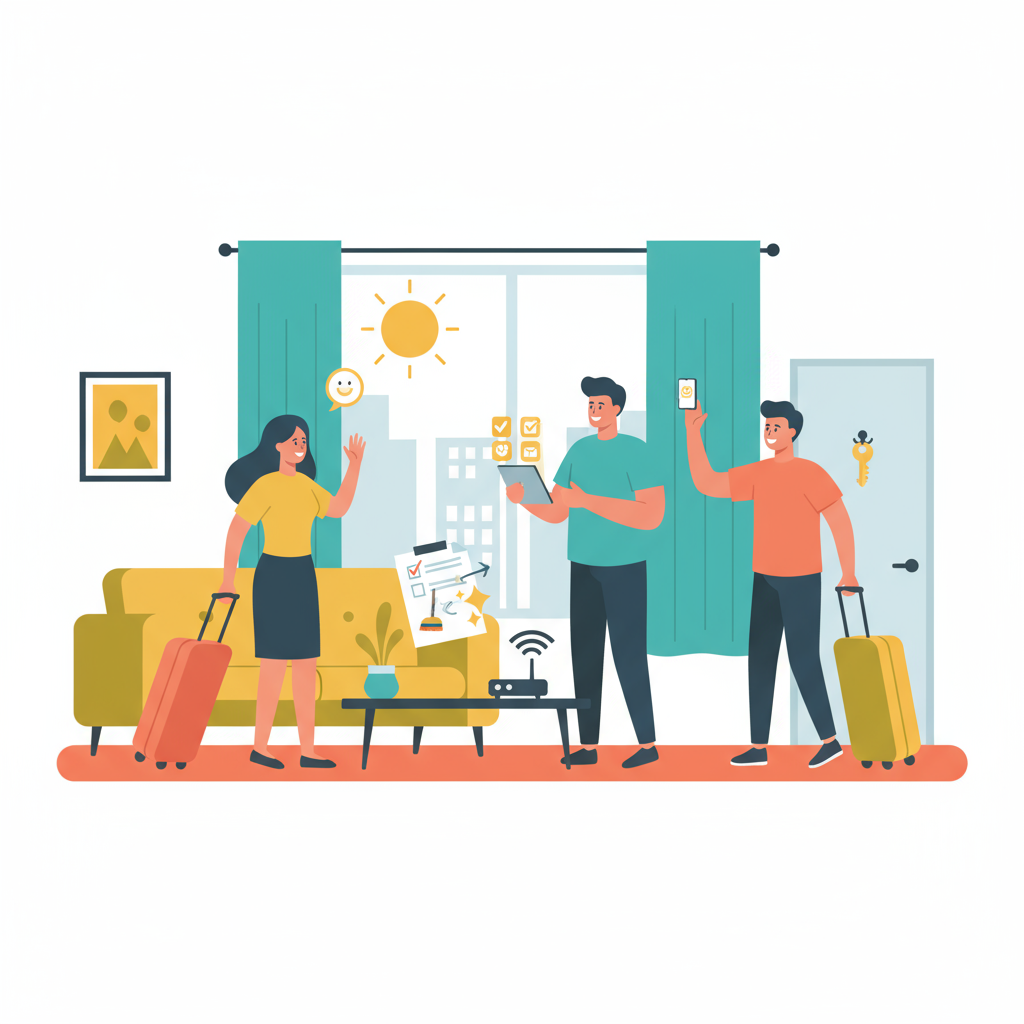Key Takeaways
Airbnb smart pricing uses real-time market data to automate your nightly rates, aiming to boost occupancy while minimizing manual rate adjustments.
The tool prioritizes filling your calendar, which can sometimes mean lower nightly earnings, especially in high-demand periods or competitive markets.
Expert hosts often layer Airbnb smart pricing with more advanced dynamic pricing systems and analytics to maximize revenue across multiple properties.
Managing a portfolio of short-term rentals means every rate, every booking, and every review impacts your bottom line.
Ever wonder why one host down the street seems to fill every weekend while your calendar has gaps? You both have great reviews, similar décor, and the same location — yet their listings stay booked. The secret might be hiding in their pricing strategy.
Airbnb’s Smart Pricing tool promises to handle this for you, adjusting nightly rates automatically to keep bookings steady. It sounds effortless — set it once, sit back, and let the algorithm do the work. But hosts who rely on it blindly often discover their listings get undervalued, especially during high-demand weeks.
In this blog, we’ll unpack how Airbnb Smart Pricing really works, what it gets right (and wrong), and which expert-approved alternatives help you stay competitive without giving up control.
Pros and Cons of Airbnb Smart Pricing
Airbnb Smart Pricing can feel like a lifesaver for busy hosts. It automatically adjusts nightly rates based on demand, seasonality, and booking trends. For anyone managing multiple properties, the idea of letting an algorithm handle the heavy lifting sounds appealing.
But like most one-size-fits-all tools, Smart Pricing comes with trade-offs. While it keeps calendars full, it often undervalues premium listings or ignores subtle market nuances that local hosts understand best. That means consistent bookings, but not always at the best price.
Here’s a quick breakdown of the biggest strengths and drawbacks:
Pros | Cons |
|---|
Free and built directly into Airbnb — no setup needed | Often undervalues high-end or unique properties |
Saves time by automatically adjusting nightly rates | Focuses on occupancy over profit, missing premium opportunities |
Reacts quickly to demand shifts and seasonal trends | Limited customization — only minimum and maximum rates allowed |
Reduces manual updates for smaller portfolios | Doesn’t sync with external channels or factor in third-party commissions |
Good for beginners learning dynamic pricing | Lacks advanced data insights or strategy control for scaling hosts |
For smaller hosts or newcomers, Smart Pricing can be a useful starting point — it teaches you how market rates fluctuate and what local demand looks like. But for hosts managing multiple listings or aiming to maximise margins, the limitations become clear fast.
Finding the right balance between automation and control is what separates average revenue from exceptional performance, and that’s where alternative pricing tools start to shine.
Enjoy the confidence & focus you need to scale your vacation rental business
Book more while doing less
With a reliable VRM solution you can trust, Uplisting can help you grow your business without wasting time on double bookings, unhappy guests, upset clients and worrying what could go wrong next.
When to Use Airbnb Smart Pricing (and When to Avoid It)
Airbnb Smart Pricing isn’t all-or-nothing. For some hosts, it’s a convenient shortcut that keeps calendars full with minimal effort. For others, it can quietly chip away at potential revenue. Knowing when to turn it on (and when to step back) is key to making it work for you instead of against you.
Expert hosts at Uplisting recommend using Smart Pricing when:
You’re managing one or two listings. If you’re new to hosting, Smart Pricing helps you learn how nightly rates change with seasons, events, and booking patterns.
Your main goal is occupancy. If you’d rather fill nights consistently than chase top-dollar bookings, Smart Pricing handles that balance automatically.
You lack time or data tools. For busy hosts without pricing software or detailed market insight, Airbnb’s built-in system is a simple, hands-off solution.
But those same expert hosts recommend avoiding Smart Pricing when:
You have a unique or high-end property. The algorithm can’t fully recognize premium features or design details that justify higher rates.
You manage multiple listings across platforms. Smart Pricing only adjusts Airbnb listings and doesn’t sync with other channels — leading to pricing mismatches or lost profit.
Your market has big event-driven demand. If your area hosts seasonal festivals, local events, concerts, or business conventions, manual or third-party pricing gives you far better control over those spikes.
Smart Pricing works best as a learning tool or a safety net, not a long-term revenue strategy. Once you understand your market’s rhythms and know how guests respond to rate changes, switching to a dedicated pricing platform gives you more control and higher margins.
How to Set Up Airbnb Smart Pricing the Right Way
Airbnb smart pricing only works as well as the limits you give it. Before turning on the feature, set minimum and maximum rates that reflect your property’s actual performance. Use last year’s data. Look at low seasons, peak periods, and weekends with special events when your occupancy climbed.
A minimum rate that fully covers costs and matches the quality of your space keeps the algorithm from driving your earnings too low in slower periods. A realistic maximum rate stops prices from scaring off guests, even when demand spikes for big events. The algorithm tends to play it safe, so it rarely pushes rates to your upper limit unless every comparable property is already booked.
Weekly check-ins are your safety net. As holidays or city-wide festivals show up on the calendar, keep an eye out for any nights where prices dip too far or fail to respond to spikes in demand. Override algorithmic pricing for outlier dates and set custom rates where needed, then let the automated tool handle regular nights.

So automatic, you won’t know what to do with yourself
Put my rentals on autopilot
It’s simple to automate repetitive tasks with Uplisting's short-term rental software. You’ll save hours every week and eliminate human error. Go ahead — take some time off.
How to Improve on Airbnb Smart Pricing
Leaning on Airbnb smart pricing alone means giving up too much control and, often, too much revenue.
Experienced hosts know automation should work for you, not dictate your earnings. For a sharper approach, blend automation with targeted strategies and smarter tools to transform pricing from a background chore into a profit driver.
Hybrid pricing strategy
A stronger pricing plan pairs automation with hands-on adjustments. Smart pricing takes care of everyday rate changes, but active oversight on key dates makes the real difference.
When a city festival, major sports event, or holiday lands on the calendar, step in and adjust rates to capture extra demand that algorithms tend to overlook. Track occupancy patterns, and if nights start booking faster than usual, nudge rates up to match the pace.
Hybrid strategies keep operations efficient without missing out on high-value moments.
Hosts running larger portfolios find third-party dynamic pricing tools, like Airdna's Pricing Tool, invaluable.
These systems give access to analytics far beyond what Airbnb offers. Set custom rules for booking pace, minimum stays, or event-driven surcharges. Compare rates directly with properties in your Comp Set instead of relying on limited comparisons. Adjust pricing for each channel, letting Booking.com listings respond to different trends than Airbnb or direct bookings. With these tools, rates react instantly to market changes, competitor shifts, and sudden surges in demand.
Combining automation, detailed analytics, and hands-on rate management lets you keep stakeholders satisfied while pushing revenue higher across every property.
How to Track and Refine Your Pricing Strategy
Pricing rarely rewards the set-and-forget crowd, especially in short-term rentals. Data tells the real story.
Weekly reports showing occupancy rate, average daily rate (ADR), and revenue per available rental (RevPAR) give direct feedback on every listing. If you manage at least six properties, split reports by property type and neighborhood. Trends love to hide in portfolio averages.
Patterns always emerge. Maybe March midweek bookings sag every year, or a local festival fills your calendar but your rates never keep up. Minimum and maximum price settings in Airbnb smart pricing often reveal where rates fall short. When bookings cluster at the rate floor or ceiling, your price boundaries need work.
Small tweaks beat big swings. Change rates by five to ten dollars and watch how bookings respond. Use A/B testing on similar units or different booking channels if your platform offers it. Over time, these targeted adjustments lead to a pricing strategy that reacts to real performance, stays flexible, and keeps each property earning its best.
Save yourself from your inbox
Automate with Uplisting
Automated guest messages keep your guest informed from booking through to check-out. They’re designed to answer questions before they arise, saving you time whilst keeping your guests happy.
Scaling Your Pricing Strategy with Uplisting
Airbnb smart pricing offers a convenient entry point for automating rates, but it’s not always built to support growing portfolios or optimize for maximum revenue. While it can help fill calendars in stable markets, its limitations become clear when managing premium listings, navigating seasonal demand, or working across multiple channels.
For short-term rental hosts serious about scaling, pairing smart pricing with dynamic tools and centralized rate controls is essential. Leveraging performance data, custom rules, and channel-specific strategies keeps your pricing competitive and aligned with your business goals. Uplisting gives you the control and flexibility needed to implement a smarter, more profitable pricing strategy across your entire portfolio.
Ready to take your pricing (and your entire operation) to the next level? Sign up for Uplisting today and see what a difference automation can make to your business.
FAQs About Airbnb Smart Pricing
Is Airbnb smart pricing automatically enabled for new listings?
Airbnb smart pricing does not switch on for new listings unless you activate it in the pricing settings. The default is manual pricing, giving you full control from the start.
How often does Airbnb adjust nightly rates?
Airbnb updates nightly rates on a daily basis or even multiple times a day when market shifts or last-minute demand changes pop up. You might log in and notice price changes for dates you haven't touched, all handled by the algorithm in the background.
Can I combine smart pricing with other dynamic pricing tools?
You need to pick one pricing tool per listing. Third-party dynamic pricing tools and Airbnb smart pricing don't run together—if you try to use both, the platforms overwrite each other's rates, which leads to confusion and possible errors.
What if smart pricing sets a price lower than my minimum rate?
Your minimum rate always acts as a hard floor. Even if market demand drops, Airbnb smart pricing never pushes your nightly price below the minimum you set in your preferences.
Does smart pricing affect my search ranking or booking visibility?
Competitive rates often lead to more bookings, which naturally bumps your listing higher in search results. Smart pricing doesn't guarantee top placement, but when your rates match guest expectations and fill nights, you may see your property surface more often in search results.
















.png)

